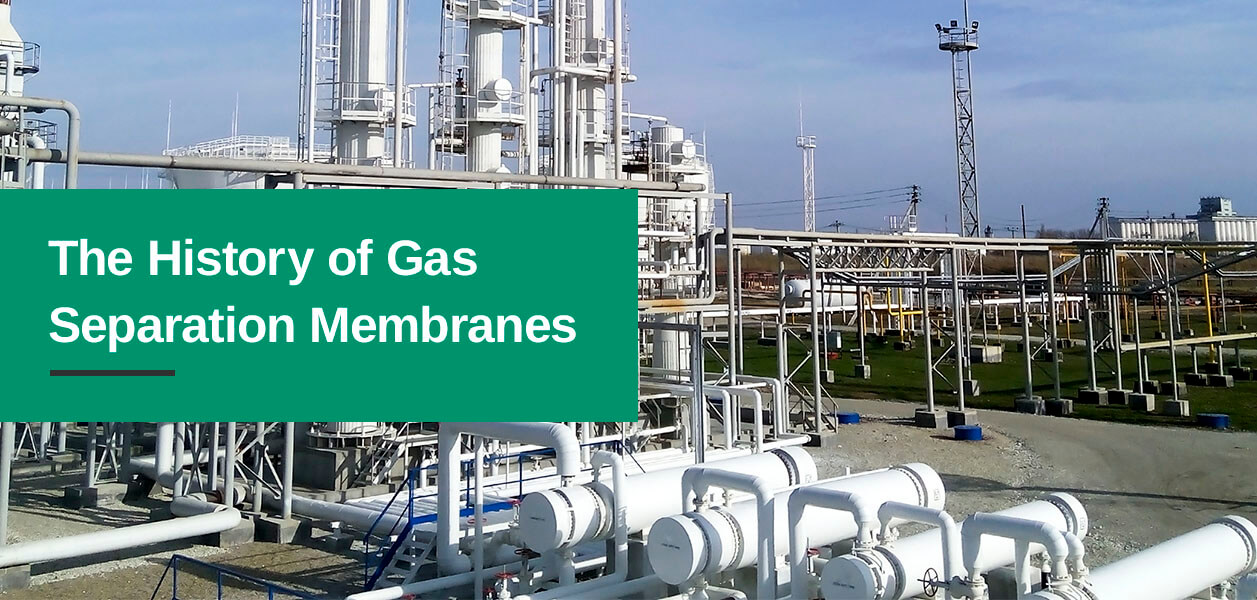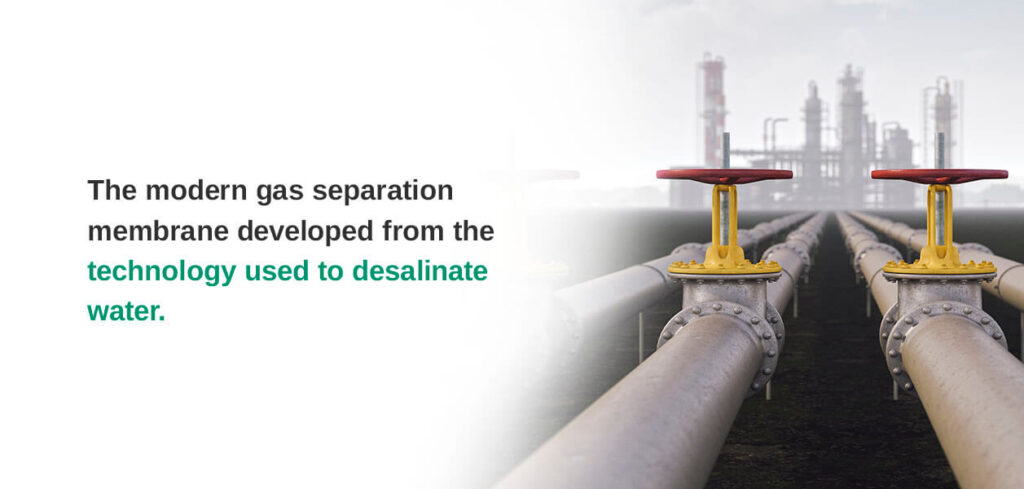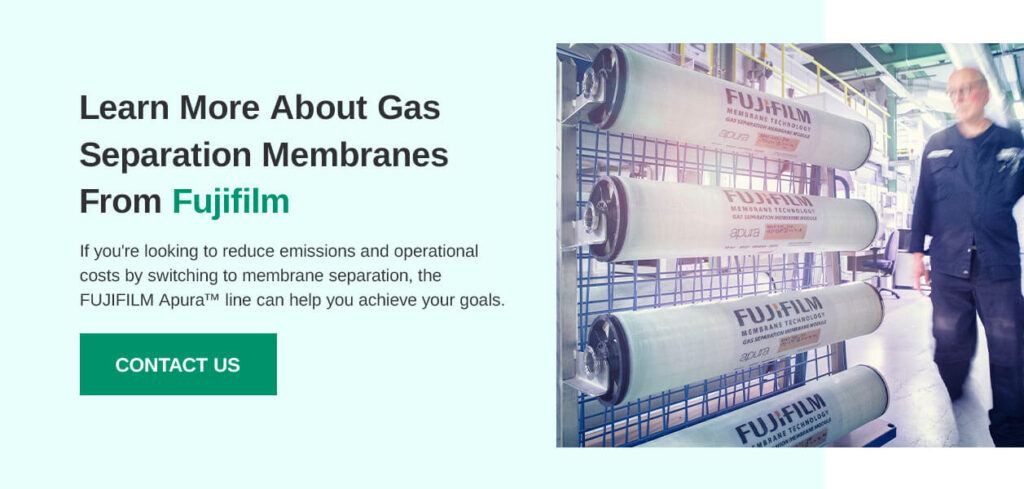
Jump to:
- What Is Gas Separation?
- Early Roots: Gaseous Diffusion in the 19th Century
- WWII: Gaseous Diffusion and Uranium Enrichment
- 1959-1979: The Creation of the Modern Gas Separation Membrane
- 1980: First Industrial Use of Gas Separation Membrane Technology
- The Future of Gas Separation Membranes
Technology advances quickly, and the gas separation industry is no different. Industrial gas separation has changed significantly from its early days. It’s enabled scientists to develop groundbreaking technologies and reduce the environmental impact of many different processes.
In this post, we’ll go through the long history of gas separation membranes, from the technology’s humble beginnings to its bright future.
What Is Gas Separation?
Gas separation is the process of isolating specific substances in a gaseous mixture. It is essential in many industrial processes, such as carbon capture and storage (CCS).
Common gas separation techniques include the following:
- Cryogenic distillation: This technique works by cooling gases down to their condensation points, then filtering out contaminants using molecular sieve adsorbents. Further purification processes often follow this step.
- Adsorption: Adsorbents attract specific gaseous molecules, which concentrate on their surface. These substances are then removed from the mixture and liquefied. This technique is common in large-scale purification applications.
- Physical absorption: Also called scrubbing, physical absorption combines a gas mixture with a liquid to dissolve specific substances into a non-volatile liquid solution. Because the non-soluble substances in the mix cannot become part of the solution, they can be easily filtered out.
- Membrane permeation: A newer method for gas separation that uses a membrane to filter out gas particles based on the difference of permeability.
Due to its business and environmental advantages, membrane permeation is currently one of the most rapidly growing techniques.
What Is a Gas Separation Membrane?
A gas separation membrane is a semipermeable barrier used to isolate and remove specific gases from a mixture.
Unlike other gas separation techniques, though, gas separation membranes do not require a phase change step. As a result, the systems are smaller and less complex than more conventional technologies. This streamlined process also reduces operational costs, so businesses can do more with less.
Some of the most common applications for gas separation membranes include:
- Removing carbon dioxide and water from natural gas
- Separating hydrogen molecules
- Recovering organic vapors from nitrogen or air streams
- Separating nitrogen from air
- Natural gas and air dehydration
- Fuel gas conditioning
- Methane production from natural gas
- Volatile organic compound (VOC) removal
Today’s gas separation technology has its roots in the theories of Thomas Graham, a Scottish chemist who worked during the 19th century. Nicknamed the father of colloid chemistry, Graham’s work laid the foundations for modern gas separation techniques.
Early Roots: Gaseous Diffusion in the 19th Century
Graham published his first paper in 1829, where he explained what would come to be known as Graham’s Law of Diffusion. This law is also often called the Law of Effusion. According to this law, a gas diffuses through a solid at a rate that is inversely proportional to its molecular weight.
Thomas’ work led to the Kinetic Theory of Gases, which holds that gas particles are constantly in a state of rapid, random motion. Because gas molecules are always moving, they can pass through tiny pores in a solid.
WWII: Gaseous Diffusion and Uranium Enrichment
The Manhattan Project, an enormous team of Allied scientists, worked throughout World War II to create the first nuclear weapons. These weapons used U235, a uranium isotope that’s extremely rare in nature — U235 only comprises about 0.7% of natural uranium.
To get enough U235 for the weapons, researchers had to enrich uranium ore. The Project formed various teams to test which enrichment technique was most effective. One group, the S-50 Project, used membrane technology to separate molecules through gaseous diffusion.
The process worked by feeding gaseous uranium hexafluoride (UF6) molecules into the plant’s pipelines, which contained a series of hundreds of porous membranes. Lighter UF6 molecules containing U235 atoms passed through the membranes faster than the heavier U238 atoms.
Researchers would collect the U235 and use it to build nuclear bombs. Even though the S-50 Project was too costly to continue for more than 69 days, the Project’s technology paved the way for gas separation innovations in the future.
1959-1979: The Creation of the Modern Gas Separation Membrane

The modern gas separation membrane developed from the technology used to desalinate water. From 1959 to 1962, researchers Sidney Loeb and Sirivasan Sourirajan developed the world’s first asymmetric reverse osmosis membrane for water treatment. This membrane was made from a cellulose acetate polymer, which was 20 times more effective than earlier technologies.
Loeb and Sourirajan later discovered that this membrane technology could also be used for gas separation. It took approximately another decade to develop the technology for large-scale use.
1980: First Industrial Use of Gas Separation Membrane Technology
Monsanto developed the first large-scale cellulose acetate gas separation membrane for hydrogen separation in 1980. Although the company was the first to commercialize this technology, many others have appeared to rival it.
In the years since this industrial breakthrough, researchers have developed new membrane technologies that have produced increasingly better results. New polymers, for example, have disrupted the gas separation industry and established new standards for effectiveness.
FUJIFILM Apura™ Gas Separation Membranes are one such innovation. Designed with a unique multilayer polymer, the Apura™ line is high-performing and resistant against contaminants like water and aromatics. Our proprietary polymer technology provides superior results compared to other materials like cellulose acetate and hollow-fiber polysulfone.
The Future of Gas Separation Membranes
As energy costs continue to rise, the gas separation industry will also expand — according to market projections, the industry is expected to grow at a CAGR of 5.87% from 2022 to 2027.
Some of the driving factors of this growth include:
- Rising demand for membranes in CO2 separation
- New developments in membrane materials
- Stronger government regulations on greenhouse gas emissions
- New applications for membrane technology
Gas separation membranes also help businesses cut costs, which will become increasingly important moving forward. Membranes have a much smaller footprint and lower environmental impact than conventional separation technologies like amine absorption and cryogenic distillation.
Learn More About Gas Separation Membranes From Fujifilm

The invention of gas separation membranes revolutionized chemical processes for businesses in various industries. If you’re looking to reduce emissions and operational costs by switching to membrane separation, the FUJIFILM Apura™ line can help you achieve your goals.
Fujifilm’s innovative proprietary membrane technology can completely replace conventional gas separation systems, enabling businesses to significantly reduce GHG emissions as well as operational and capital expenses.
Contact us today for more information about our high-performance Apura™ gas separation membranes. One of our expert team members will be in touch to answer any questions you may have.













